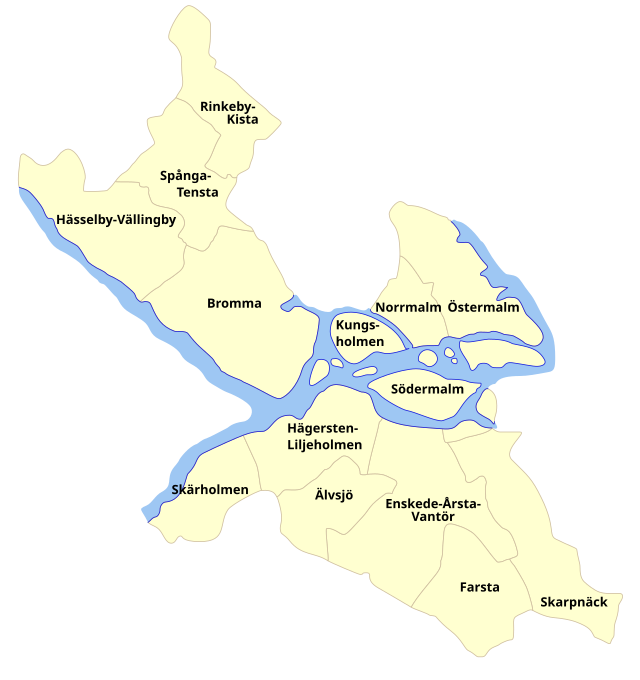Municipalities in Sweden are in some rare cases divided into smaller districts or urban districts, and are sometimes assigned administrative boards responsible for certain areas of governance in their respective areas. These districts are not specified by national Swedish law, but rather are created by individual municipalities, and thus the Swedish names of these districts vary greatly from municipality to municipality, including kommundelar, stadsdelar, stadsdelområden, primärområden, or stadsdelsnämndsområden. The degree of administrative autonomy of these districts similarly varies greatly, but is normally very limited.[citation needed]
On 1 January 2016 a new form of division of Sweden was introduced. This division is called Districts or Registration districts, in Swedish Distrikt. These are used for certain administrative purposes by some national authorities, such as land ownership and statistics. This is not the same as the urban districts which are divisions held by some municipalities.
Stockholm
Overview
Metropolitan Stockholm consists of 26 municipalities (boroughs), each municipality is divided into smaller subdivisions/districts.
Stockholm Municipality uses the English term "district" (Swedish: stadsdelområde) to describe these subdivisions.[citation needed]
The districts were first created in 1997 to facilitate the efficiency of local government in Stockholm. The number of districts was reduced from 24 to 18 the following year, and reduced again to the current 14 in 2007. Since the establishment of these districts, certain administrative tasks, such as school administration were re-centralized.[citation needed]
Each district has its own district administration, led by a district council, which is responsible for certain areas of municipal governance within their district, including pre-school education, park maintenance, local economic initiatives, elderly services, financial counseling, and refugee reception services. Individual district councils have no power over city planning or tax policy, both of which are retained by the central city council.[1][2]
The councilors that serve on these district councils are often part-time politicians, also holding other employment. They are preferably residents of the district whose council they serve upon. The central city council itself is responsible for setting the budget, goals, and responsibilities of the district councils. The city council also appoints the members of each district council, so the political makeup of the district council resembles that of the central city council, not necessarily that of the district. The member of the district council are not elected in any fashion by the residents of the district in question.[2]
Stockholm's 14 districts are sometimes divided into smaller parts for statistical purposes, however these smaller districts have no administrative function in the city's governance.[citation needed]

Boroughs
Metropolitan Stockholm has 26 municipalities (boroughs):
Districts
Stockholm municipality has 14 districts as of the administrative changes made in 2007:[2]
Gothenburg
Overview
Gothenburg Municipality (Göteborgs stad) is also divided into subdivisions which it refers to as "districts" in English, though as with Stockholm's districts, they are often referred to as boroughs in unofficial contexts. The Swedish term used by the city council is stadsdelsnämndsområden (literally "city-part committee area"). These districts were created in 1990. Just like in Stockholm, these districts each have a local governing body which Gothenburg calls "district committees." These committees serve a nearly identical function to Stockholm's district councils, including recreation, local economic issues and social services, and the lower levels of the education system, and like Stockholm's councils, these committees are appointed by the centralized city council.[3]
Gothenburg is divided into 21 districts, each with a district committee. These 21 districts can be further divided into 94 subdivisions (called primärområden/primary areas) which exist only for statistical and organizational purposes, and serve no administrative function.
Districts
The 21 districts of Gothenburg and the primärområden enclosed within each:[4]
|
|
|
Malmö

Overview
Malmö Municipality (Malmö stad) is divided into five districts (Swedish: stadsområden).[5][6] These districts each have a board or council called a stadsdelsfullmäktige, each consisting of eleven members, which are responsible for various local administrative tasks. In Malmö, the district councils are also responsible for assisting members of the community in contacting their politicians or navigating their way through government agencies.[7]
Districts
These are the five districts of Malmö:
Other examples
Other smaller municipalities in Sweden also use municipal subdivisions for official purposes, however these are not always administrative. For example, Strängnäs Municipality uses district councils (kommundelsråd) which serve a purely advisory function and have no administrative power.[8]
Borås Municipality is divided into ten districts (kommundelar), each with a district council (kommundelsnnämd) responsible for pre-school and primary school, recreational services, and services for the elderly.[9]
Torshälla is a region inside Eskilstuna Municipality which has withheld a degree of autonomy since merging with Eskilstuna, including their own city council (Torshälla stads nämnd).[10]
Other municipalities that use districts for advisory or administrative purposes include Huddinge, Kalmar, Köping,[11] Södertälje,[12] Umeå[13] and Västerås.[citation needed]
See also
References
External links
Wikiwand in your browser!
Seamless Wikipedia browsing. On steroids.
Every time you click a link to Wikipedia, Wiktionary or Wikiquote in your browser's search results, it will show the modern Wikiwand interface.
Wikiwand extension is a five stars, simple, with minimum permission required to keep your browsing private, safe and transparent.